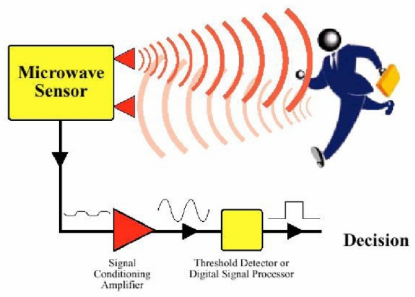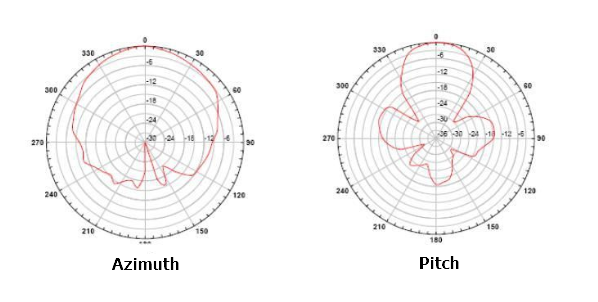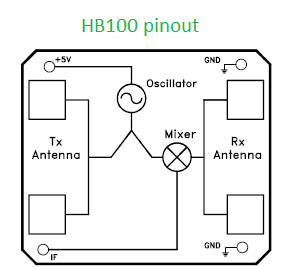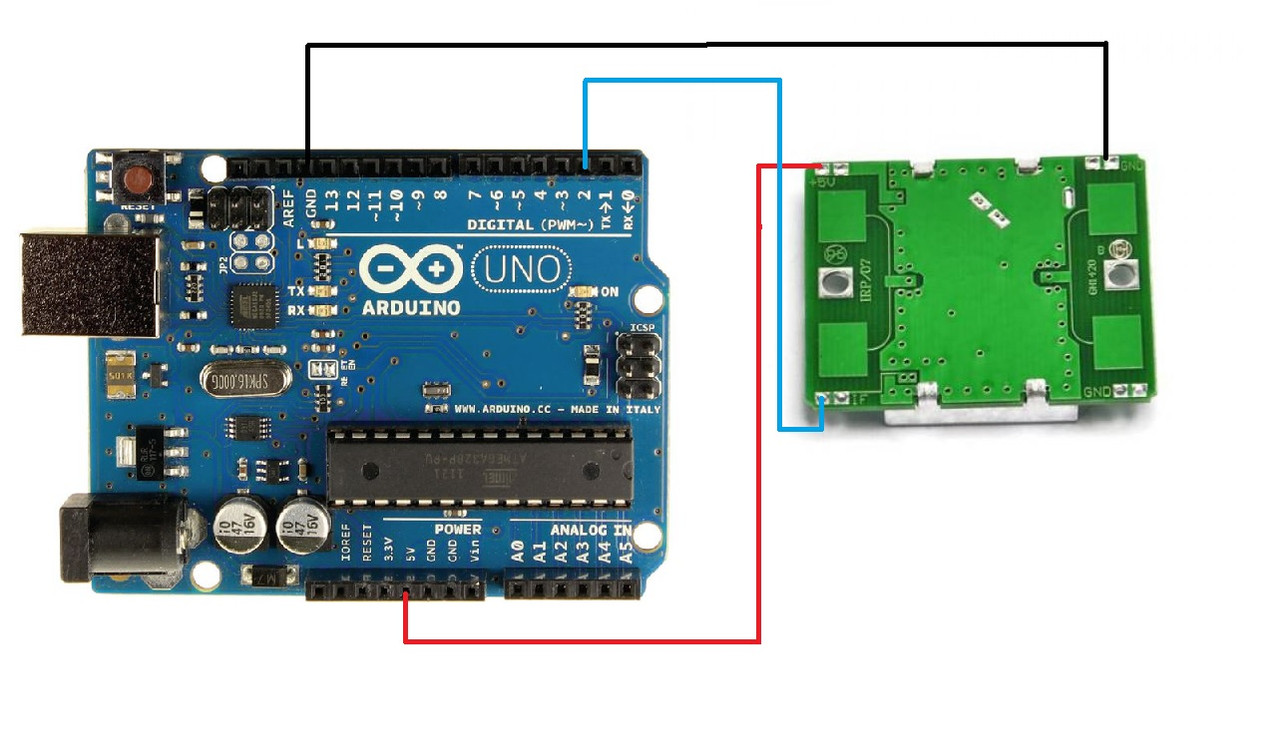AED 33.50
Description
The HB 100 microwave motion sensor module is a non-contact detection device that uses radio-frequency waves to detect motion. It has a highly resistant design to radio-frequency interference and is capable of detecting motion up to 20 meters away. With a low output power of 5mW and compact size, it is a low-cost and low-power consumption solution for motion detection in harsh environments. The module is independent of temperature, humidity, noise, airflow, dust, light, and other environmental factors. It operates on the Doppler principle, using radio waves to detect changes in motion.
Package Includes:
- 1 x HB100 Microwave Motion Sensor Module
Features:
- Non-contact detection: The module uses radio-frequency waves to detect motion without the need for physical contact with the object.
- Doppler principle: The module operates on the Doppler principle, using radio waves to detect changes in motion.
- Detection range: The module has a detection range of over 20 meters, making it suitable for a wide range of applications.
- Highly resistant to RF interference: The module is designed to filter out external RF signals and is capable of operating in environments with high levels of RF noise.
- Independent of environmental factors: The module is designed to be independent of temperature, humidity, noise, airflow, dust, light, and other environmental factors. This makes it suitable for harsh environments.
- Low power consumption: The module has a low output power of 5mW, making it a low-power consumption solution for motion detection.
- Compact size: The module has a compact size of approximately 1.75 x 1.45 x 0.3 inches (4.4 x 3.7 x 0.8cm), making it easy to integrate into a variety of applications.
- Low cost: The module has a low cost, making it a cost-effective solution for motion detection.
Description:
The HB 100 module is a non-contact motion detection sensor that operates on the Doppler principle. It uses radio-frequency (RF) waves to detect motion in its surrounding environment. When an object enters the sensor's detection range, the RF waves emitted by the sensor reflect off the object and return to the sensor. The sensor then analyzes the frequency shift in the reflected waves to determine the object's velocity and direction of motion. One of the key advantages of the HB 100 module is its high resistance to RF interference. It is designed to filter out external RF signals and is capable of operating in environments with high levels of RF noise. This makes it an ideal solution for applications where RF interference is a concern. The module has a detection range of over 20 meters, making it suitable for a wide range of applications, including security systems, industrial automation, and traffic monitoring. It has a low output power of 5mW, which makes it a low-power consumption solution for motion detection. The HB 100 module is also designed to be independent of temperature, humidity, noise, airflow, dust, light, and other environmental factors. This means it can operate reliably in harsh environments where other types of sensors may be affected.
Principle of Work:
The module operates on the Doppler principle, which states that the frequency of a wave will change if the source or the observer is moving. In the case of the HB 100 module, it emits radio-frequency (RF) waves toward the environment and detects changes in the frequency of the reflected waves to determine the presence and motion of objects. When an object enters the sensor's detection range, the RF waves emitted by the module reflect off the object and return to the sensor. The frequency of the reflected waves is shifted due to the movement of the object. If the object is moving toward the module, the frequency of the reflected waves will be higher than that of the emitted waves. Conversely, if the object is moving away from the module, the frequency of the reflected waves will be lower than that of the emitted waves. The module analyzes the frequency shift in the reflected waves to determine the object's velocity and direction of motion. The module then outputs a signal indicating the presence and motion of the object to the system it is connected to, such as a security system, industrial automation system, or traffic monitoring system. One of the key advantages of the HB 100 module is its high resistance to RF interference. The module is designed to filter out external RF signals and is capable of operating in environments with high levels of RF noise. This makes it an ideal solution for applications where RF interference is a concern.

Signal Detection Range
The module has a detection angle of 72 degrees in the azimuth direction, which refers to the horizontal angle of detection. This means that the module can detect motion within a range of 72 degrees horizontally from the sensor. In addition to the azimuth direction, the module also has a detection angle of 36 degrees in the pitch direction, which refers to the vertical angle of detection. This means that the module can detect motion within a range of 36 degrees vertically from the sensor. It's important to note that the detection angle of the module can be affected by various factors, such as the position and orientation of the module, the surrounding environment, and the sensitivity of the sensor. Therefore, it's recommended to test the module in the actual application environment to determine the optimal position and orientation for the best results.

Pinout of the Module:

- GND: The GND pin is used to connect the module to the ground of the system it is being used with. The Vcc pin is used to provide a power supply of 5V to the module. It's important to note that the module has a low power consumption, typically around 50mA, which makes it suitable for battery-operated systems.
- Vcc: The OUT pin is the output pin of the module, which provides a signal indicating the presence and motion of objects detected by the module. The signal is a digital signal, which means that it can be easily interfaced with a microcontroller or other digital circuitry
- OUT: When an object is detected by the module, the output signal goes high, typically around 3.3V or 5V, depending on the power supply voltage. The output signal remains high as long as the object is within the detection range of the module. When the object moves out of the detection range, the output signal goes low.
Applications:
- Security Systems: The module can be used in security systems to detect intruders and trigger alarms or other actions.
- Automatic Doors: The module can be used in automatic door systems to detect the presence of a person or object and open the door automatically.
- Motion-Controlled Lighting Systems: The module can be used in lighting systems to automatically turn on lights when motion is detected and turn them off when there is no motion.
- Industrial Automation: The module can be used in industrial automation systems to detect the presence of objects and trigger actions or processes.
- Traffic Monitoring Systems: The module can be used in traffic monitoring systems to detect the presence and motion of vehicles and provide data for traffic analysis and management.
- Robotics: The module can be used in robotics to detect the presence of obstacles and enable the robot to avoid collisions.
- Health Monitoring Systems: The module can be used in health monitoring systems to detect the motion of patients and provide data for healthcare professionals to monitor their health status.
Circuit:

- GND: The GND pin is used to connect the module to the ground of the system it is being used with. The Vcc pin is used to provide a power supply of 5V to the module. It's important to note that the module has a low power consumption, typically around 50mA, which makes it suitable for battery-operated systems.
- Vcc: The OUT pin is the output pin of the module, which provides a signal indicating the presence and motion of objects detected by the module. The signal is a digital signal, which means that it can be easily interfaced with a microcontroller or other digital circuitry.
- OUT: When an object is detected by the module, the output signal goes high, typically around 3.3V or 5V, depending on the power supply voltage. The output signal remains high as long as the object is within the detection range of the module. When the object moves out of the detection range, the output signal goes low.
Library:
No need for a library to work with this module but you can use the next library, download this file then unzip and upload the FreqPeriod.zip file to your Arduino IDE as Library.
Code:
This code sets up an Arduino microcontroller to detect motion using a microwave motion sensor module connected to a specific pin (defined as SENSOR_PIN).
#define SENSOR_PIN 2 // Define the pin connected to the OUT pin of the module
#define SAMPLING_INTERVAL 1000 // Define the sampling interval in milliseconds
unsigned long lastSampleTime = 0; // Variable to store the time of the last sampling
int motionDetected = 0; // Variable to store the detection status
void setup() {
Serial.begin(9600); // Initialize the serial communication for debugging
pinMode(SENSOR_PIN, INPUT); // Set the sensor pin as input
}
void loop() {
if (millis() - lastSampleTime >= SAMPLING_INTERVAL) { // Check if it's time to take a new sample
lastSampleTime = millis(); // Update the time of the last sampling
motionDetected = digitalRead(SENSOR_PIN); // Read the sensor output
if (motionDetected == HIGH) { // If motion is detected, print a message to the serial monitor
Serial.println("Motion detected!");
// Add code here for what to do when motion is detected, such as turning on a light or triggering an alarm
}
}
// Add additional code here for other tasks to run continuously, such as monitoring other sensors or performing calculations
}
- In this code, the
SENSOR_PINis defined as the input pin connected to the OUT pin of the module. TheSAMPLING_INTERVALis defined as the time interval between each sampling of the sensor output. ThelastSampleTimevariable stores the time of the last sampling, and themotionDetectedvariable stores the detection status. - In the
setup()function, the serial communication is initialized for debugging, and the sensor pin is set as an input. - In the
loop()function, the time since the last sampling is checked, and if it's time to take a new sample, the sensor output is read and checked for motion detection. If a motion is detected, a message is printed to the serial monitor, and additional code can be added for what to do when motion is detected, such as turning on a light or triggering an alarm.
Technical Details:
- Detection Range: Over 20 meters
- Output Power: 5mW;
- Dimension(L x W x T): Approx. 1.75 x 1.45 x 0.3 inch / 4.4 x 3.7 x 0.8cm
- Non-contact detection
- Independent of temperature, humidity, noise, airflow, dust, light, etc., suitable for
1. Transmitter:
- Frequency: 10.525GHz
- Frequency Setting Accuracy: 3MHz
- Power Output (Min.): 13dBm EIRP
- Operating Voltage : +5V +/- 0.25V
- Operating Current (CW): 60mA max, 37mA typical
- Harmonic Emissions: -10dBm
2. Receiver
- Sensitivity (10dB S/N ratio) in 3Hz to 80Hz bandwidth : -86dBm
- Noise in 3Hz to 80Hz bandwidth: 10μV
- Antenna Gain: 8dBi
- E Plane 3dB Beamwidth : 36′.
- H Plane 3dB Beamwidth: 72′
Resources:
Comparisons:
The HB100 and HC-SR501 are both passive infrared (PIR) motion sensor modules, but the HB100 is a microwave sensor while the HC-SR501 is an infrared sensor, Here are some of the key differences:
- Detection range: The HB 100 has a much longer detection range of over 20 meters compared to the HC-SR501's range of 5-7 meters.
- Detection angle: The HB 100 has a wider detection angle of 72 degrees in the azimuth direction and 36 degrees in the pitch direction, while the HC-SR501 has a narrower detection angle of 120 degrees.
- Sensitivity: The HB 100 has a lower sensitivity compared to the HC-SR501, which means it may not be as good at detecting smaller motions or movements further away.
- Power consumption: The HB 100 has a lower power consumption than the HC-SR501, making it a better option for battery-powered devices.
- Price: The HC-SR501 is generally more affordable compared to the HB 100, which can be more expensive.
In terms of applications, the HB 100 is often used in industrial settings due to its long-range detection capabilities, while the HC-SR501 is more commonly used in home automation and security systems. the choice between the two sensors will depend on the specific needs of the project, such as the required range, sensitivity, and power consumption.